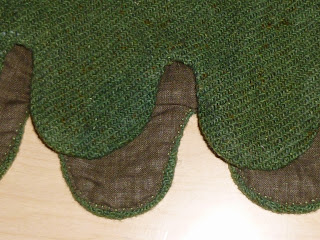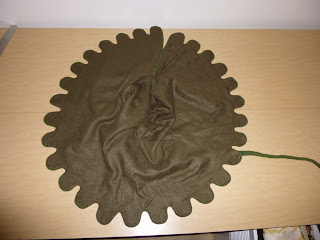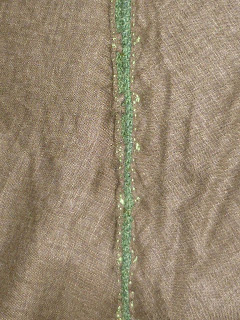It's a liripipe hood!
Judging from my sketchbooks, I made this sometime around the beginning of August 2012. I had been reading a book on Medieval costume from the school library when I came across a picture of a liripipe hood. I immediately decided that liripipe hoods were awesome and that I needed to make one.
A definition of the word "liripipe" can be found here, some Medieval illustrations of them can be seen here, and an article on hoods and liripipes can be read here.
From what I remember reading in the book they were a man's garment that was popular around the 14th century. They were usually made of wool and the liripipes were separate pieces that were sewn on to the back of the hood. With all the fashionable men trying to outdo each other, the liripipes kept getting longer and longer until they had to be tied into fancy knots to keep them from dragging on the ground.
The pattern is pretty simple so it didn't take much work. I drew the pattern on an old sheet and used that as a mockup. It seemed to fit okay. It is loosely based off of hood #4 in this illustration.
 |
| The light spot was caused by a stain on the blanket that blocked some of the dye. |
My mother teaches dyeing and has a small dye kitchen right outside my room, which is quite useful when something isn't the right colour.
 |
| The scraps that I didn't dye. |
I don't really mind.
 |
| Oops. |
 |
| The inside of the hood. |
 |
| It tapers to quite a small point. |
 |
| The hole repair is on the left, the liripipe join on the right. |
(Side note: What does spell-check have against costumers? It didn't accept liripipe or dagging as words. Look what it's fist suggestion for "liripipe" was.
 |
| Lipizzaner?? |
 |
| The outer fabric sticks out about 3 mm further than the lining. |
The buttons themselves are actually little felt balls, a bit smaller than a marble. I wet felted them using green merino roving.
I like the way the loops outline the buttons in brown.
Here is the button closure from the inside.
The garment is lined in a thin brown cotton. The lining seams are the only part that is sewn by machine. There wasn't quite enough of the cotton, so one half of the lining has some piecing it it. The lining ends at the point where the liripipe is attached and is tacked into place.
 |
| You can't see the piecing in this picture, but it's on the right side. |
It got compliments when I wore it, but nobody knew what to call it. I was asked several times if I put my braid in the liripipe. What a dumb question. A braid would obviously not fit in there and even if it did it would be very awkward because the liripipe is so far up on the head.








This is the coolest thing ever. I've never seen this kind of garment before.
ReplyDeleteIn regards to your question: "Did you make that?" (which really isn't that dumb of a question, but it happened to come right after I had just spent a few minutes explaining exactly how I'd made it)
Thank you!
DeleteThat is a pretty dumb thing to ask under the circumstances. It's so irritating when you try to explain things to people and they don't pay any attention.
I remember these hoods from old movies and the TV series about Robin Hood (the legend of whom dates from the 13th and 14th centuries). And probably other movies set in that period, the names of which I can no longer recall. I confess that I didn't know what it was called, but I surely had seen them. And I would have bet money that nobody at your school would have known the correct name either. Not even the fashion people. It's an obscure article of clothing by anyone's standards.
ReplyDeleteI don't recall ever having seen one in a movie, but I haven't seen many Medieval era movies.
DeleteNone of the people in the fashion studio recognized it, which is quite sad. Liripipes deserve wider recognition.
This is just plain cool. I totally want one now - do you think it would be weird to wear it to, like, Starbucks or the grocery store? ...because I totally want to....BRING BACK THE LIRIPIPE!!!
ReplyDeleteThat is EXACTLY what I thought the first time I heard of liripipe hoods. "What? These things went out of fashion 600 years ago and haven't made a comeback?"
DeleteI don't think it would be weird to wear one at all. I wore mine to school and to an art gallery and nobody seemed to think it was weird.
It would be awesome if you made one! The world needs more liripipes. I'm actually planning on making another one, black with inward curves instead of scallops, which would be more my style and would get worn more often.
Thankfully, they are super quick and easy to make.
This is awesome! I have a cloak that I wear around campus in lieu of a jacket, but the hood is much too wide (basically a wind-sock for my head) and it won't stay on. I've decided a closer-fitting liripipe hood should be my next project (the liripipe just for fun). You've pretty much spelled out everything I need to get it going, so thanks! Looking forward to joining the new... er, revival.
ReplyDeleteYay! I'm glad this was helpful. Good luck with your liripipe hood!
DeleteOh my god, too damn awesome! :D
ReplyDeleteThanks so much for showing us your awesome creation, a job well done!
It's truly inspirational to see such fine craftsmanship.
How much time did you spend making it?
I'm dreaming of making a couple of these MAXIMUM SWAG liripipe hoods one day :)
Greetings from the north, aka Norway :-)
Alexander Sørnes
Thank you!
DeleteI have no idea how much time I spent making it. This was long before I started keeping time sheets on anything.
Good luck with your own liripipe projects!
was looking for inspiration and found this. there is a practicle side to the liripipe only just being rediscivered: it keep your open hood from blowing away in the wind. just loop it once through the back of your belt and even if the hood blows off you're having chase it being blown away. nothing more undignified than a lady chasing her hood through a muddy field in an epic game of keep-away with the wind.
ReplyDeleteJust discovered this, and it's THE coolest thing! Thank you so much for sharing your lovely creation!
ReplyDelete